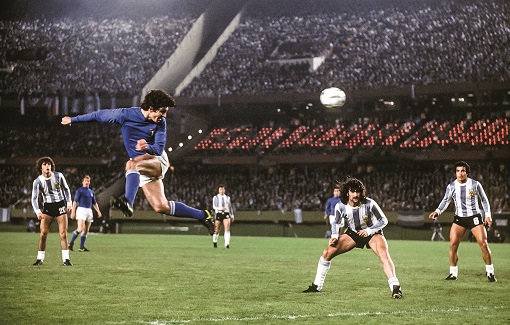
Paolo Rossi, the Italy striker, sends a spectacular header towards goal during a 1‒0 win over Argentina
Brit reviews ‘The Age of Innocence – Football in the 1970s’ a stunning new photographic book published by TASCHEN…
Golden Age-ism ‑ the idea that in a particular era the stars shone brighter, the greats were greater and the men were real men instead of spoilt prima donnas or professional drones – is a common strand of thought in discussions of sporting history. And sometimes there’s a deal of truth in it. Today’s crop of Test cricket fast bowlers – worn down by endless money-spinning tours, flat pitches and tailend batsmen confident in their protective helmets – are pale imitations of Lillee, Thomson, Holding and the other terrifying 1970s speed demons. But often Golden Age-ism is just the nostalgic illusion of old men, and every generation thinks it lived it.
Another common strand, not always contradictory, is the patronising view that previous eras – because the people didn’t know what we know now – were innocent, quaint, faintly comical and essentially a practice for the real business of today. It doesn’t often occur to proponents of this view that future generations might likewise chuckle at our current mores.
Whether your view of 1970s soccer is that it was a quaint run-up to the ‘modern game’ or a Golden Age from which we’ve declined, you can find confirmation of it in the stupendous new TASCHEN photographic book The Age of Innocence – Football in the 1970s. The editors hedge their bets and go for both, declining to put a question mark after ‘Innocence’ but also claiming that in the 70s
the game was at its most beautiful, free-flowing and entertaining. Football became truly international thanks to extraordinarily talented teams and charismatic players who became the first generation of football superstars, long before David Beckham stripped down to his underwear.
On the ‘innocent’ side are the toe-curling commercials and promo stuff. There seemed to be a particular craze for advertising new kits by photographing a star player in his normal civvies standing next to a dolly bird wearing the football strip. There is a gruesome one of Kenny Dalglish sitting at a table in an inexplicably grubby pub, grinning over a pint of mild and a soiled ashtray, while behind him a lass in a Scotland kit stretches provocatively across a couple of bar stools.
On the Golden Age side of the argument are the superstars. The Age of Innocence is a terrific record of a positive constellation of stars: some, like Johann Cruyff, at their peak; others just past it and milking the Major League Soccer cash (Pele, Moore, Best), and others yet to it reach it. There are some wonderful snaps of a fifteen-year old Diego Maradona packing to join his first professional club, and then a few years later sitting at the hairdresser getting his trademark perm. The photos of the stars are exceptionally good and often intimate (including Franz Beckenbauer and Gerd Muller sharing a double-bed, Morecambe and Wise-style; and, alarmingly, a full frontal of Pele in the showers).
But was football really at its ‘most free-flowing and entertaining’ in the 70s, as Golden Age-ists claim? Watch archive footage now and the games seem laughably slow. World Cup matches are at walking pace with players facing almost no pressure on the ball outside the attacking third. English domestic games are played on atrocious muddy pitches with a heavy ball and defenders who simply attempted to kick talented attackers into the stands. They could also pass back to the goalkeeper. (Not enough is made, I feel, of the positive transformative effects on the game of the 1992 backpass rule. It forced goalies to become comfortable footballers – which has effectively eliminated the position of the sweeper – but also made it worthwhile for attackers to aggressively pressurise defenders on the ball, forcing defenders to become better footballers in turn. The days of the unskilled, brutal ‘donkey’ centre-back are over. It has also massively improved the game as a spectacle – people reminisce fondly about the great 1980s Liverpool sides, but once they went 1-0 up there was a hell of a lot of Lawrenson-to-Hanson-and-back-to-Grobbelaar-ing). To my mind football in 2014 has more exciting attacking play and much higher all-round skill levels (even goalkeepers can do Cruyff-turns these days).
On these pages James Hamilton has written convincingly that the idea of a 1970s Golden Age is largely a myth. He has also pointed out that football was a ‘finished project’ as a spectator sport as early as 1913, when “121,919 people could ride brand new electric trains and trams to the beautiful stadium at Crystal Palace, buy a glossy colour match souvenir and, surrounded by lakes and parkland, watch Sunderland and Aston Villa, the two richest sides in England” contest the FA Cup final.
But of course what they didn’t have in 1913 was glorious colour action photography. This is a tremendous, enormous, beautiful, endlessly fascinating collection of pictures by top-notch snappers including Neil Leifer, Peter Robinson, Gerry Cranha and Terry O’Neill book. The RRP is a thumping £34.99, but if you’re seeking the perfect gift for the soccer aficionado or 70s nostalgist in your life, this is it.
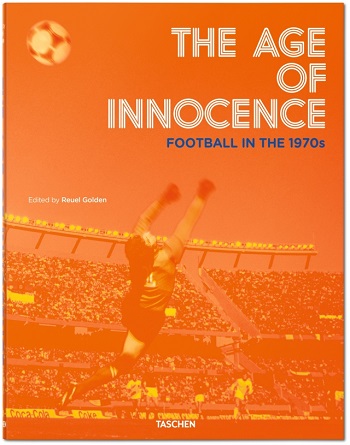 The Age of Innocence. Football in the 1970s (edited by Reuel Golden) is published by TASCHEN.
The Age of Innocence. Football in the 1970s (edited by Reuel Golden) is published by TASCHEN.


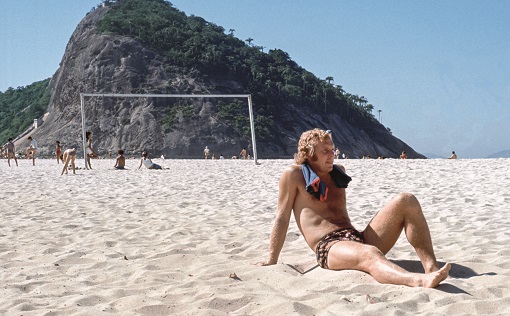
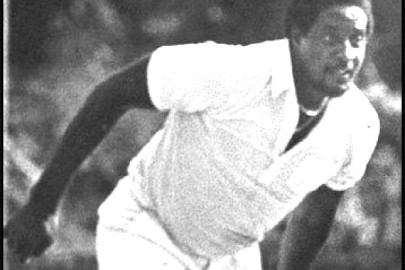
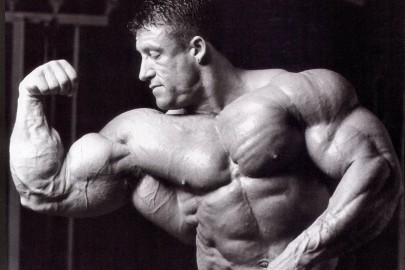
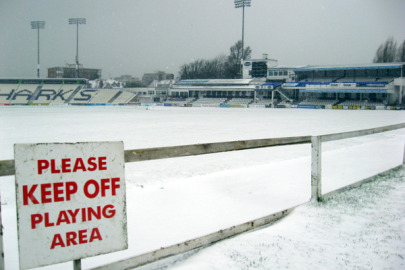







The seventies were doomed from the start, what else can we expect when an era is heralded in during the dying days of the previous decade by a werewolf.
Brilliant song though but.
Purchasing from Taschen’s flagship store, on Köln’s Hohenzollernring, requires the use of a substantial forklift truck, many of the books are chunky in the extreme, transporting Calatrava’s book back to junior’s apartment left me with a permanent stoop.
World Cup matches are at walking pace with players facing almost no pressure on the ball outside the attacking third.
I watched as much of the World Cup as I could. I’ll spare you the standard North American rant about diving. (Actually, I won’t. It’s out-of-control and shameful, and I was unimpressed with commentators claiming it’s a skill and “part of the game”. Kudos to the Aussies for taking their tackles like men). Anyway, I was blown away by the stamina, ball control and aggressive defence everywhere on the field. A player receiving the ball was lucky to have half a second to decide what to do with it.
24/7 conditioning and scientific precision has obviously improved the skill level of soccer dramatically, as it has with hockey, but it seems dependably to favour defence and work against cinderella teams. This divides purists from dabblers like me who think nothing in sports is more beautiful than a soccer goal. The goal-heavy group play was wonderful, but I snored my way through the quarters (three 1-0 and one 0-0 games) and the seemingly inevitable defeats of exciting pretenders like Colombia. So I don’t think it’s just middle-aged nostalgia, it’s also a yearning for more offensive flair, mistakes and unpredictability. Thank goodness for Brazil.
The English Premier League has the most exciting football (and has better quality throughout the league so you get more upsets than the Spanish La Liga, which has the two best teams). Pleasingly, last season England’s two most attractive attacking teams – Man City and Liverpool – finished in the top places, ahead of the more functional Chelsea.
The top four European leagues, where all the world’s top players are – England, Spain, Italy, Germany – all average just under 3 goals per game, and the Champions League, where the best of that lot get to play each other, is a terrific spectacle. The only problem is that it has taken away some of the mystique that used to surround the World Cup, because all the players are familiar to us and the standard is lower than the best club football.
That said, 2014 was a pretty great World Cup, I thought, especially the Central American teams in the group stages and Brazil’s meltdown.
For offensive flair and extreme unpredictability check out the great biter himself,Luis Suarez!.
Oh yes, plus Messi, Robson, Rodriquez and quite a few others. No shortage of individual flair, but as the tournament progressed, they seemed more and more isolated, trying to perform one-man miracles in the face of dauntingly formidable defensive walls (Festung Germanica). Perhaps this is inevitable and can’t be addressed without rule changes (it’s an issue in hockey), and good defence is a skill too. But while a pitchers’ duel in baseball can be exciting, four in a row points to batting issues.
I agree it was a good tournament, especially because nobody seemed to be playing for draws. You should do a post someday on soccer culture—announcers, spectators, players, national presidents, etc. It’s quite different from all the North American sports.
BTW, why did they drop the golden goals they experimented with several years ago?
I don’t think of the period as a golden age; more a decade of golden moments; golden hours; and even those were often cast into the shadows by mindless on and off-field thuggery: Ramsey’s England of 1970, better than that of ‘66, co-contributors with Brazil to the greatest match of the tournament, played out in a Mexican heat more suited to the crematorium than the football arena; Banks’ save from Pele’s header, a moment destined to become one of sport’s most enduring visual cliches of brilliance, requiring a ten second period of digestion before acceptance that it really happened; those astonishing Brazilians: Pele, Tostao, Rivelino, Jairzinho, Carlos Alberto, Gerson; those equally astonishing Dutch, with an on-field leader responsible for a million copycat dislocated knee joints; the mercurial Cruyff gliding, ballerina-like, into the German penalty area in the first minute of the’74 Final; the unhesitating blast of the whistle from Jack Taylor – penalty! Jan Tomaszewski, a heartbreaker, as clowns often are; Don Revie, glorious saviour of English football; Don Revie, ****, he of a resignation via the pages of the Daily Mail; Argentina ‘78, a snowstorm of tickertape: Kempes, Ardiles, Luque, the mighty Passarella: “The cup is ours – understand, gringo?” Well yes, if you put it like that – take it. There were golden moments, golden hours, but, apart from the emergence of the concept of total football, not a golden age. How could it be when two of its local heroes were Norman ‘Bites yer legs’ Hunter and ‘Chopper’ Harris?
John, not forgetting Jack “ah divvent knaa wat ya takin aboot ref” Charlton, Leeds finest WMD. Went on to manage the Borough, a football team steeped in the outfall from ICI and British Steel.
He certainly knew how to put himself about, Malty, but I think we have to concede that he played a vital part in the success of that outstanding Leeds United team, and was mightily effective with England. But if Peter Swan, the Sheffield Wednesday centre half, and Jack’s almost exact contemporary, had not got involved in that infamous 1962 betting scandal, the Leeds giraffe may never have had the chance to stick his neck out for England. Anyway, none of that bunch of 70s cloggers could hold a candle to the most fearsome wing half I ever saw, one James Scoular of Newcastle United and Scotland, old thunder thighs himself: “Boss, when are we playing Newcastle?” “23rd December!” “Oh, sorry Boss, I’m visiting me granny in hospital that day.”
From The Independent’s obituary: ‘Jimmy Scoular was a footballing volcano, and certainly not of the dormant variety.A fearsomely combative Scot from a flinty mining upbringing, he tackled like a runaway coal wagon and was prone to explosive eruptions of fury, yet he possessed precise passing skills which could change the course of a game. It was said of him that he played sometimes as if he hated everyone on the field, demolishing opponents, bawling-out team-mates and confronting referees, but it wasn’t true. He was a decent man with a tremendous sense of humour, and there was no hate in him. It was just that he was obsessed with the game and, more particularly, the winning of it.’
This was interesting about ’70s football:
http://www.theguardian.com/football/2014/jul/25/west-brom-three-degrees-book-extract
One forgets how close the stars were to the public. That’s probably the biggest change: the money, the celebrity.